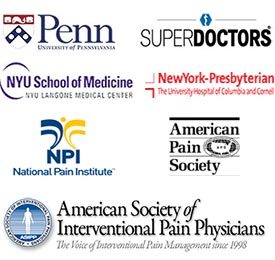NYC Ankle Sprain Specialist Doctors
At Manhattan Pain and Sports Associates you’ll get the ankle sprain pain management and doctor’s care you need to reduce or eliminate your ankle pain. Because when you’re in pain — whether it’s from an accident, sport injury age, or ailment — you want relief quickly. Appropriate and targeted ankle sprain pain management and treatment starts with a proper diagnosis from your NYC sports pain medicine management specialist.
Ankle Sprain
You’re in good company if you sprain your ankle. The American Academy of Orthopaedic Surgeons reports that approximately 25,000 people experience a sprained ankle every day in America. And it happens in equal measure to athletes and non-athletes in Manhattan. Adults and children who just stand up the wrong way can sprain their ankles.
A sprained ankle happens when you turn your ankle in a direction that it’s not meant to go. When it turns, twists or rolls and then you step on it, you apply enough force to stretch the ligaments beyond the range of their capabilities.
Anatomy of an Ankle
Your ankles act like hinges. They’re composed of bones and joints, ligaments, muscles, blood vessels, tendons and nerves. This structure is unique in that ankles are designed to support one and a half times your weight when you walk and up to eight times your weight when running. Your NYC pain management doctor will tell you that any condition that interrupts this delicate balance can cause you pain and disrupt your ability to walk.
An ankle is made up of three bones covered in cartilage that makes movement smooth and painless. The cartilage serves as shock absorbers that are intended to last your entire lifetime. Ligaments attach bone to bone while tendons attach muscles to bones. Most of your movement relies on the muscles that run from your legs, around your ankles, to your feet.
Grade Your Sprain
Depending on the severity of your sprain, your pain management specialist determines the best line of treatment. The injuries are rated from mild to moderate and severe. Sprains typically are divided into three categories:
- Grade one is the least painful and results in only mild damage to the fibers in the ankle ligaments.
- Grade two sprains occur when you’ve torn one of the ligaments and your ankle joint gets loosened.
- Grade three makes it nearly impossible for you to walk on because there’s been a complete tear of at least one ligament.
Following a grade one sprain, you’ll have mild swelling. More swelling with a decreased ability to walk without pain accompany a grade two sprain. With a grade three sprain, you’ll experience significant tenderness and swelling, along with little to no stability in the joint. You won’t be able to walk without pain.
Treatment Options
An X-ray can tell your pain management doctor whether your pain is due to an ankle fracture instead of an ankle sprain. An MRI can reveal the soft tissue so the doctor can determine the extent of the ligament damage. For a grade one sprain, R.I.C.E. typically suffices as a healing treatment. This common treatment involves:
- Rest
- Ice
- Compression
- Elevation
R.I.C.E. may be enough for a grade two sprain as well, but most likely it will take you longer to completely recover. You may need a brace or a cast to treat a grade three sprain, after which you’ll undergo more intense rehabilitation to regain your range of motion and proper gait. Surgery is rarely used to treat a sprain unless your ankle doesn’t respond to conservative treatments over the course of a few months.
Get the Relief You Need
Your NYC sports pain management doctor will do his /her best to get you back to your normal routine and back in the game with minimal downtime. After your rankle sprain diagnosis is confirmed, your doctor begins your ankle sprain pain management and treatment plan with the most conservative pain relief treatment. You’ll always receive non-invasive pain relief before your doctor turns to more invasive procedures like surgery.
Manhattan Pain and Sports Associates
51 East 25th St, 4th Floor, Ste B
New York, NY 10010
(212) 533-3954



